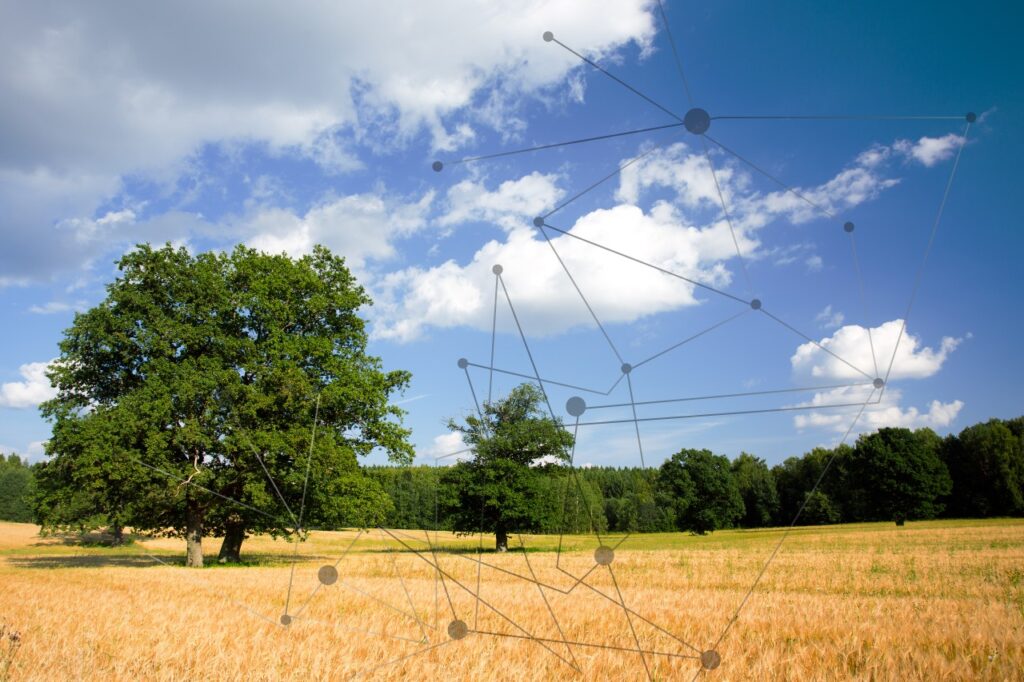Introduction
Satellite-based Internet of Things (IoT) technology is transforming global agriculture by providing data-driven insights that enhance farm management, improve crop yield, optimize resource use, and help address the growing challenges of food security and environmental sustainability. As agriculture increasingly relies on precision farming practices, Satellite IoT in global agriculture connects remote sensors, equipment, and vehicles, enabling farmers and agricultural businesses to make data-driven decisions from almost anywhere on the planet.

Key Components of Satellite IoT in Agriculture
Satellite Connectivity:
Satellite IoT utilizes Low Earth Orbit (LEO), Medium Earth Orbit (MEO) and Geostationary Orbit (GEO) satellites to establish connectivity in remote areas, where terrestrial networks (e.g., cellular or LPWAN) may be unavailable or unreliable. The connectivity provided by satellite networks enables the seamless transmission of data from sensors and other IoT-enabled devices in fields, regardless of geography.
IoT Sensors and Devices:
There are countless possible sensors used in agriculture to provide ground truth data. Temperature humidity, flow, pressure,
- Soil Sensors: Monitor soil moisture, pH, and nutrient levels, helping optimize irrigation and fertilization practices.
- Weather Stations: Provide hyperlocal weather data, such as temperature, humidity, and rainfall, essential for understanding microclimates and predicting adverse conditions.
- Crop Health Monitors: Sensors and cameras can assess plant health, detect diseases early, and monitor growth rates.
- Livestock Trackers: Wearable devices track the location, health, and behavior of animals, helping improve livestock management.

Data Analytics Platforms:
- Data collected from IoT sensors is processed and analyzed to produce actionable insights. Advanced analytics platforms use machine learning and AI to detect patterns, make predictions, and optimize agricultural operations in real time.
- Visualization tools display data on dashboards or mobile apps, making it easy for farmers to interpret insights, take action, and remotely manage operations.
Applications of Satellite IoT in Agriculture
Precision Farming:
Satellite IoT enables farmers to tailor their use of water, fertilizer, and pesticides based on specific crop needs, reducing waste and environmental impact. For example, soil moisture sensors can trigger automated irrigation only where needed, conserving water resources.
Crop Monitoring and Yield Prediction:
Satellite IoT can monitor crop growth across vast expanses of farmland, providing data on crop health, biomass, and even stress conditions like drought or pest infestations. This information helps farmers predict yields more accurately and take preventive measures to protect crops.
Livestock Management:
By tracking livestock with satellite IoT devices, farmers can monitor animal health, location, and behavior in real-time. This allows for proactive health management, reduces the risk of disease spread, and helps manage grazing patterns efficiently.
Supply Chain Optimization:
IoT sensors along with satellite connectivity can monitor crops and livestock from production through transportation, ensuring optimal conditions are maintained to reduce spoilage. This helps improve food quality and reduces waste in the supply chain.
Climate Adaptation and Resilience:
Satellite IoT aids farmers in responding to climate-related challenges by providing real-time data on weather patterns, soil conditions, and other factors impacted by climate change. This enables farmers to adapt quickly, using resilient practices and optimizing resources based on current environmental conditions.
Benefits of Satellite IoT in Agriculture
Global Reach and Connectivity: Enables IoT device connectivity even in remote, rural, and underserved areas worldwide, expanding precision agriculture to regions lacking terrestrial networks.
Increased Efficiency and Cost Savings: Automating resource use, crop management, and livestock tracking helps farmers reduce labor, conserve resources, and lower operational costs.
Improved Yields and Food Security: By maximizing resource use efficiency and predicting crop health and yields, Satellite IoT contributes to increased productivity, helping meet global food demands.
Environmental Sustainability: Reducing unnecessary resource use (water, pesticides) and optimizing fertilizer applications decrease environmental impact, supporting sustainable agricultural practices.
Challenges and Considerations
Cost of Deployment: High initial costs for satellite IoT infrastructure and devices may be prohibitive for smaller farms or regions with limited financial resources.
Data Privacy and Security: As farms become more data-reliant, ensuring secure transmission and storage of agricultural data becomes crucial.
Data Processing and Interpretation: The large volume of data generated requires advanced processing capabilities, and actionable insights must be made accessible to farmers in a user-friendly format.
Regulatory and Policy Issues: Agricultural data use and satellite IoT technology deployment are influenced by country-specific regulations, which can impact the speed and scale of adoption.
Future Prospects
As satellite technology advances, the costs are expected to decrease, making Satellite IoT more accessible. The continued development of nanosatellites and low-power devices will expand Satellite IoT’s reach, making global agriculture increasingly data-driven, resilient, and efficient. With these advancements, Satellite IoT has the potential to play a vital role in addressing global challenges, from food security to sustainable farming practices, helping build a more productive and environmentally friendly agricultural sector.